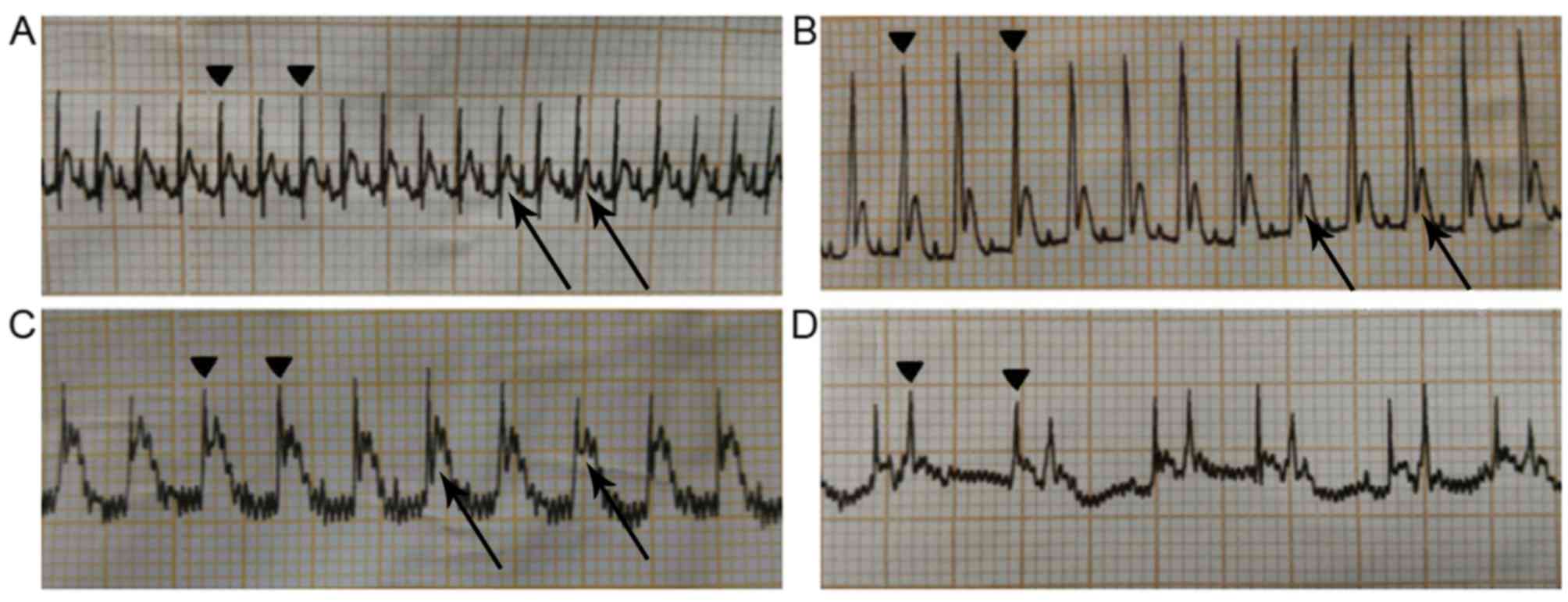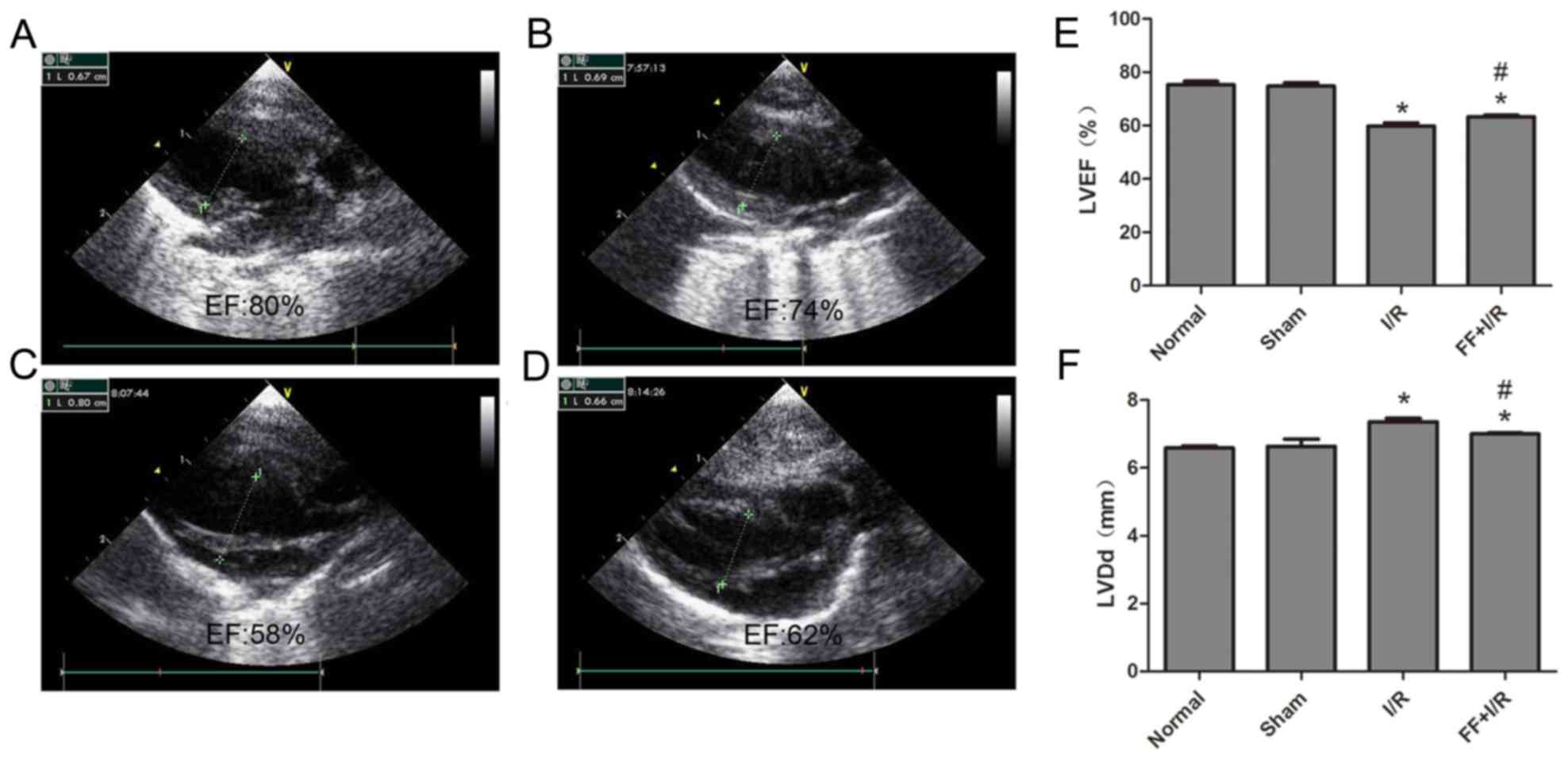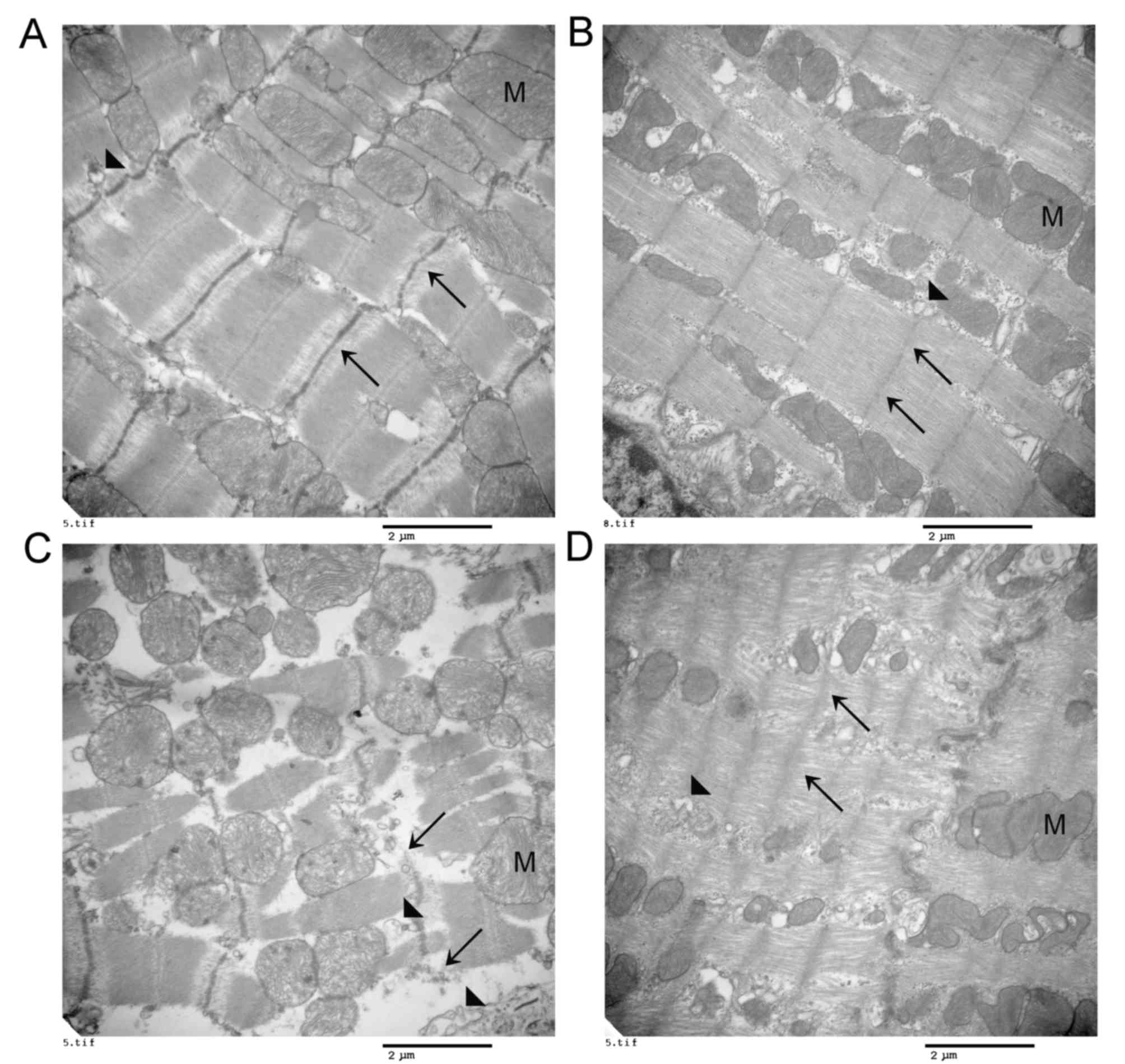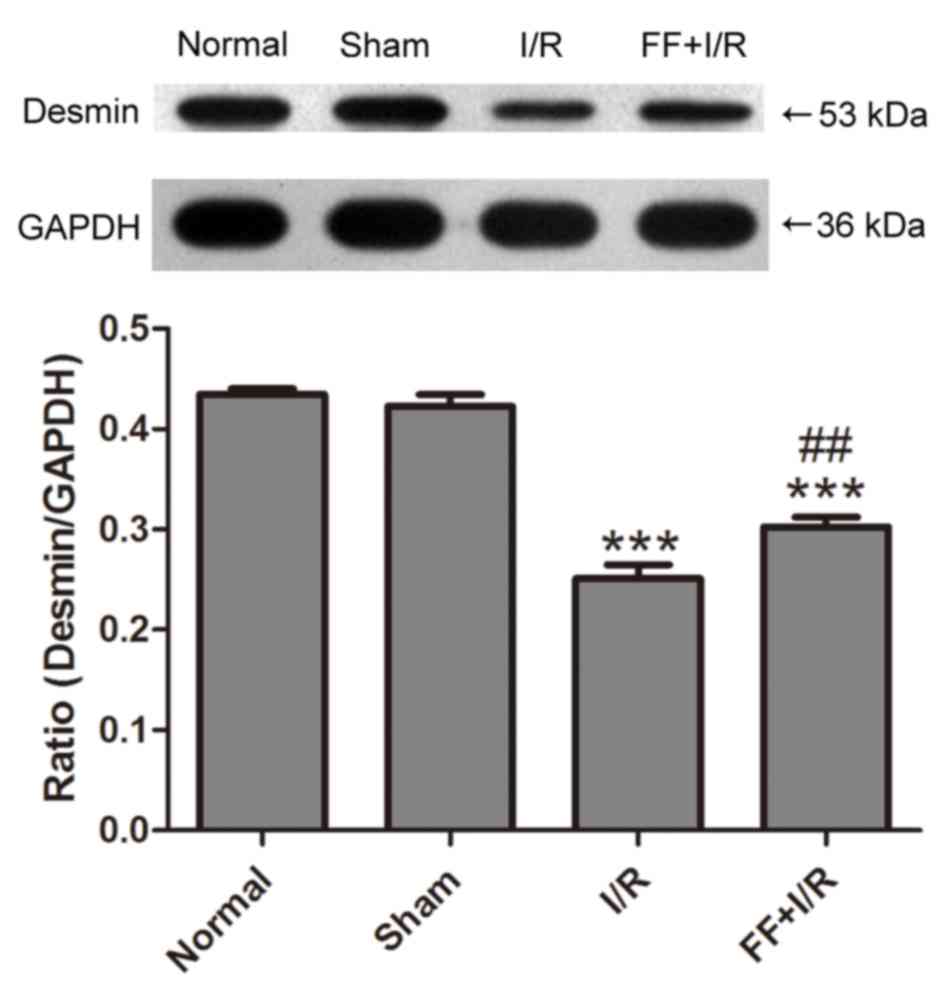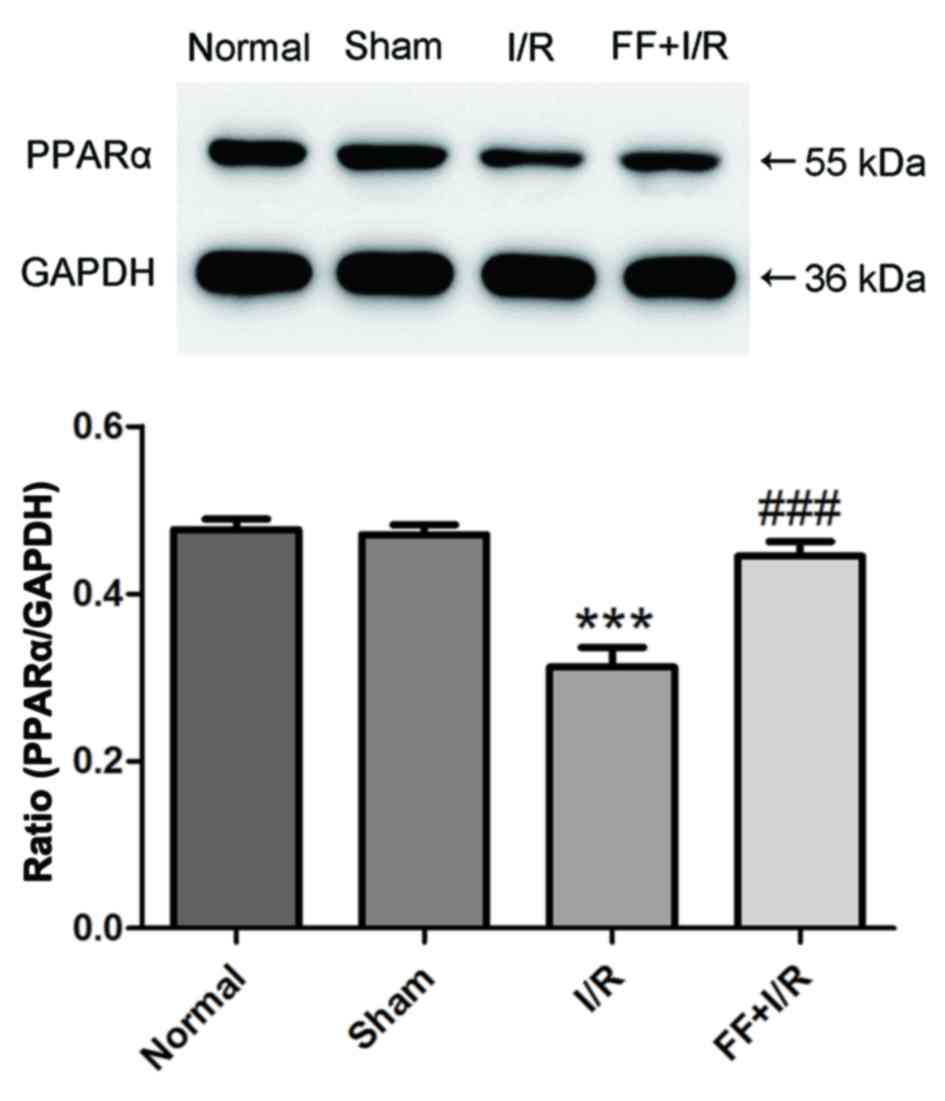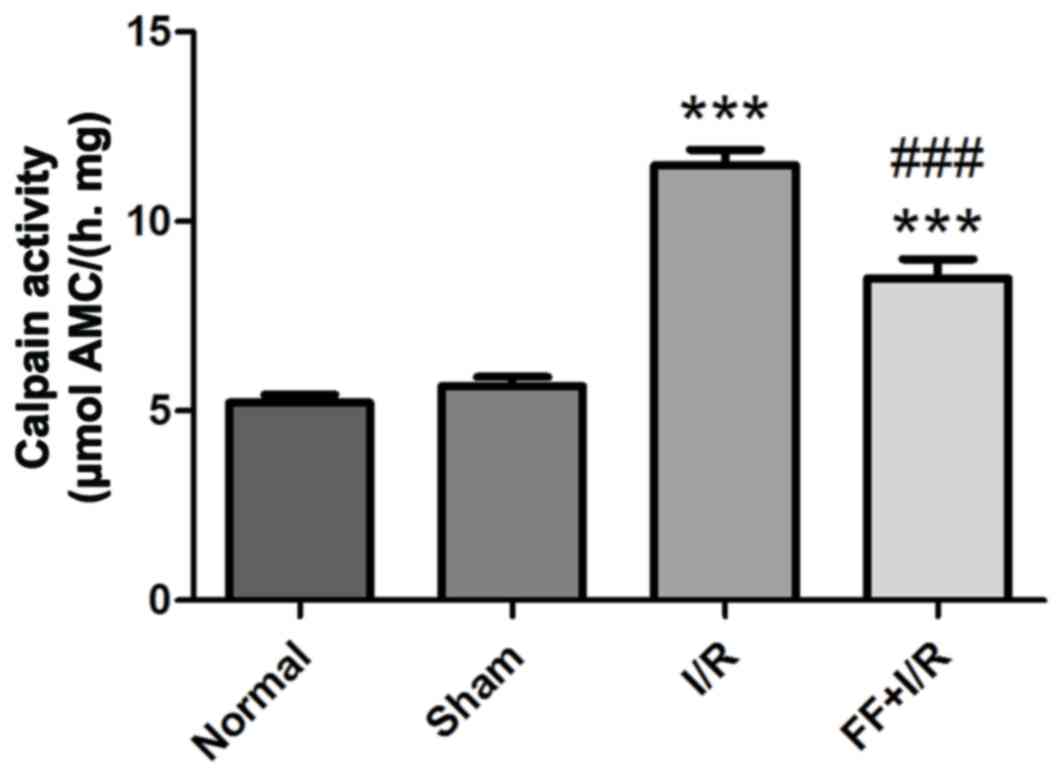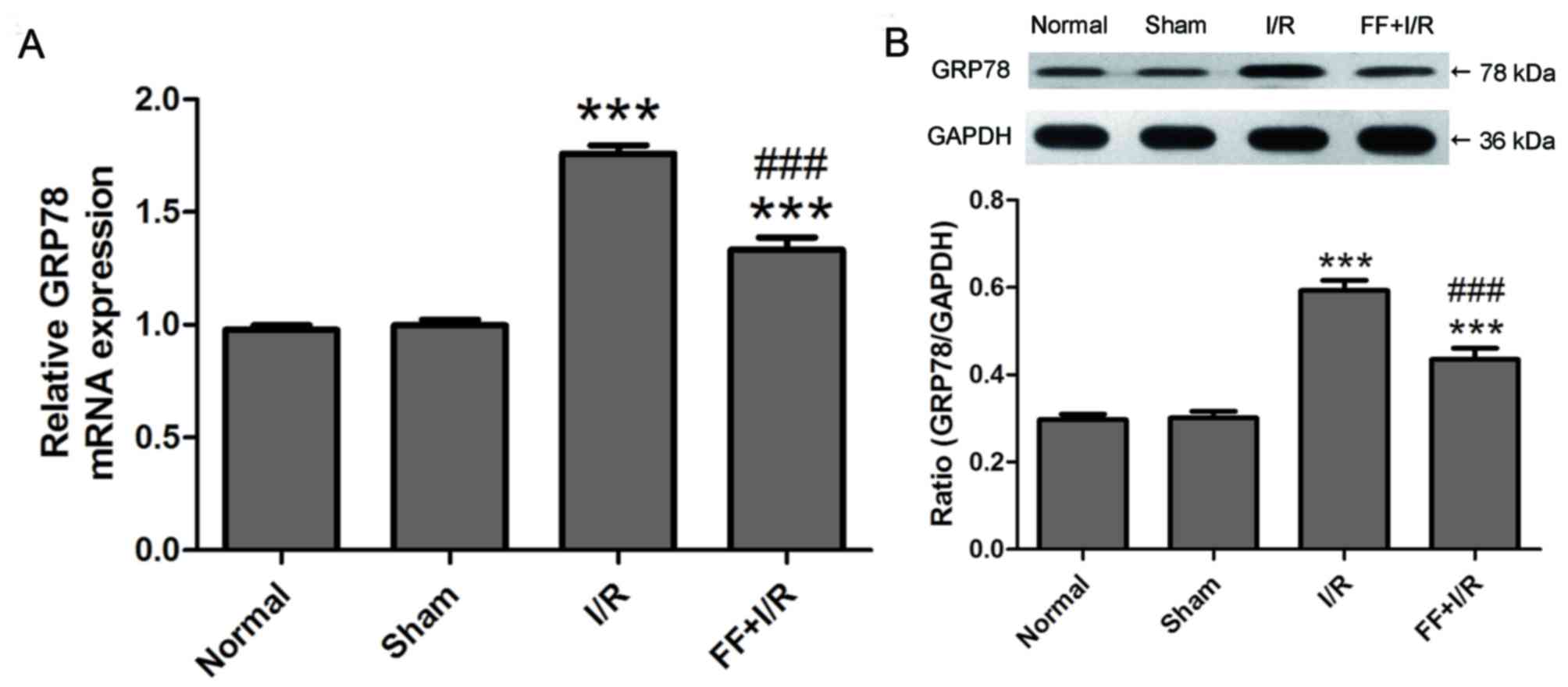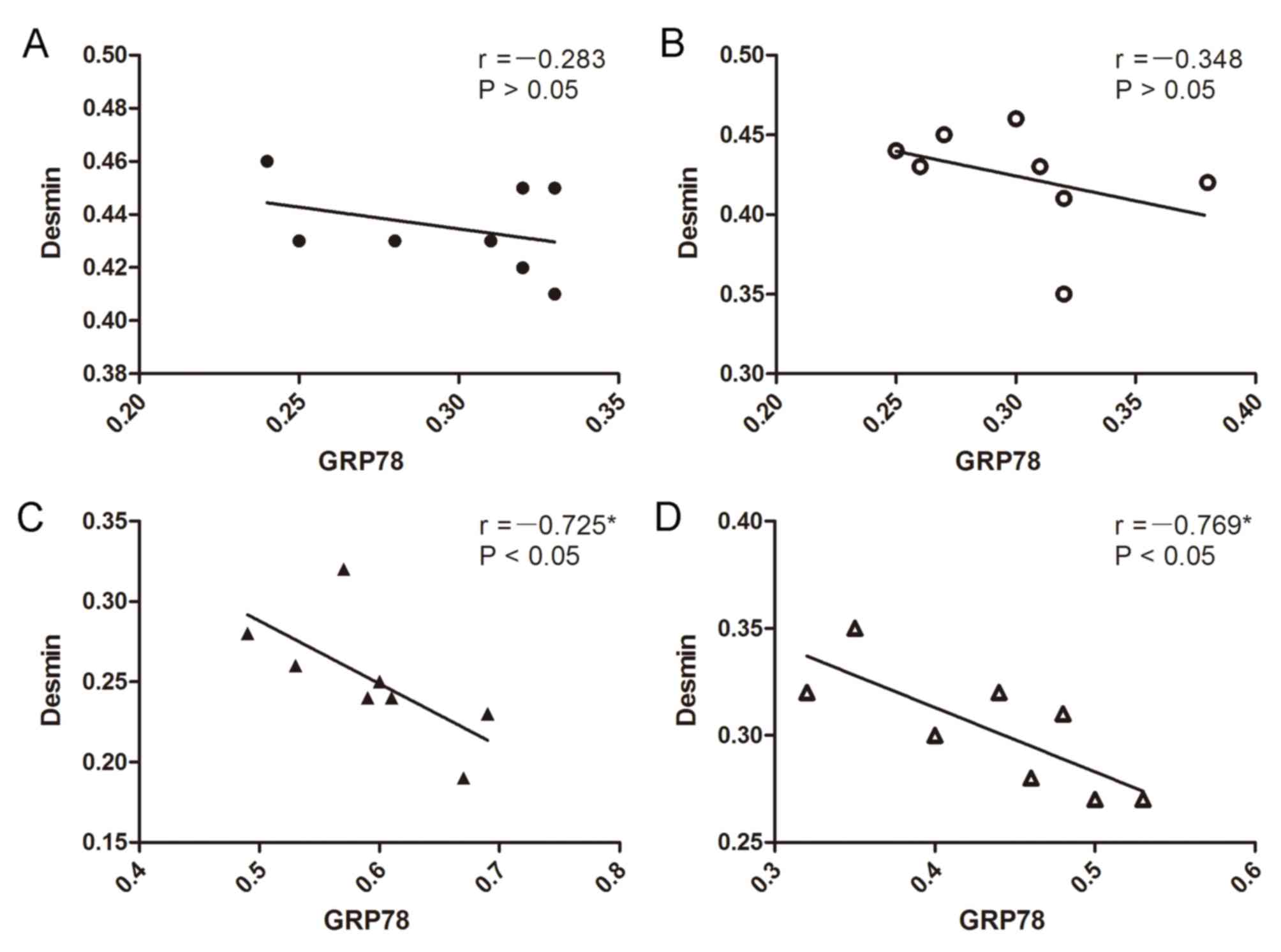PPARα activation alleviates damage to the cytoskeleton during acute myocardial ischemia/reperfusion in rats
- Authors:
- Published online on: March 16, 2018 https://doi.org/10.3892/mmr.2018.8771
- Pages: 7218-7226
-
Copyright: © Yuan et al. This is an open access article distributed under the terms of Creative Commons Attribution License.
Abstract
Introduction
The cytoskeleton is a reticular structure involved in maintaining cellular morphology and physiological function, and it is susceptible to the calpain system, which may be activated by high concentrations of calcium during myocardial ischemia/reperfusion (I/R) injury (MIRI). The endoplasmic reticulum (ER) is a dynamic membranous network which is involved in various physiological processes, including protein synthesis, steroid hormone synthesis, intracellular calcium homeostasis regulation and molecular signal transmission (1). ER stress that disrupts ER function may occur in response to radiation, ischemic stress, glucose and lipid metabolic disorders, and other cellular stressors, which lead to the accumulation of unfolded and misfolded proteins in the ER and calcium dyshomeostasis. In the early stages of ER stress, the ER may decrease the damage to cells caused by unfolded and misfolded proteins, via activation of transcriptional and translational pathways. However, sustained or serious ER stress may cause alterations in the lipid composition and calcium reserves of the ER, and cytoskeletal degradation and inflammation may be induced by the imbalance of homeostasis in the cells (2). Studies have confirmed that ER stress is implicated in the pathogenesis of diseases, including I/R injury, shock and cancer (3,4). Previously, reperfusion injury was significantly alleviated by ER stress inhibitors in an in vivo model of liver, myocardial and cerebral acute I/R (5–7).
Peroxisome proliferator-activated receptor α (PPARα) is a subtype of transcription factors of the nuclear receptor superfamily. It is highly expressed in various metabolically active organs, including the liver, heart and kidney. PPARα serves a critical biological role in regulating the expression of target genes by forming heterodimers with the retinoid X receptor, including genes involved in mitochondrial β-oxidation, ketogenesis, lipoprotein transport and glycolysis (8). A previous study revealed that, besides regulating energy metabolism and inflammatory responses, PPARα serves a key role in intervening in the occurrence and development of disease by regulating stress reactions (9). Research in the liver has shown that ER stress may be suppressed by activating PPARα; in fatty liver tissue, PPARα activation reduced the accumulation of lipid droplets and apolipoprotein B-100 in the hepatic ER, corrected the disturbance in the lipid composition of the ER and upregulated the expression of sarcoplasmic reticulum Ca2+ ATPase, resulting in the prevention of the induction of ER stress and an improvement in hepatic steatosis associated with fructose consumption (10). In addition, PPARα was associated with the prevention of ER stress induced by the disturbance of lipid metabolism in cardiac cells by enhancing AMP-activated protein kinase activity (11). A previous report demonstrated that PPARα activation may alleviate acute I/R-induced injury to the mitochondrial ultrastructure, and the underlying protective mechanism involves the antioxidant effect of PPARα (12). However, there are few studies that demonstrate the protective effect of the PPARα on the cytoskeleton and ER stress during MIRI. Therefore, the present study aimed to determine the protective effect of PPARα activation on myocardial I/R injury in rats and to investigate its possible underlying mechanisms in ER stress. The present study demonstrated the protective effects of fenofibrate on I/R heart tissue through ER stress inhibition in the myocardium. These results provide a theoretical basis for future clinical trials for fenofibrate in patients with reperfusion injury.
Materials and methods
Animals
A total of 48 male Wistar rats (age, 6–8 weeks; weight, 160–220 g) were bred in-house (Laboratory Animal Center, The Second Affiliated Hospital of Harbin Medical University, Harbin, China) and had ad libitum access to food and water. Rats were maintained at a controlled temperature (22±2°C) and humidity (50–70%). All animals were housed in a controlled pathogen free environment with 12-h light and dark cycles. All protocols for animals were performed strictly in accordance with the guidelines for the Care and Use of Laboratory Animals, and the present study was approved by the Ethical Committee of The Second Affiliated Hospital of Harbin Medical University.
Myocardial I/R injury model
Wistar rats were randomly divided into four groups (n=8 rats/group): Normal group (normal); sham group (sham); I/R group (I/R); and fenofibrate pretreatment + I/R group (FF+I/R). Fenofibrate (Sigma-Aldrich; Merck KGaA, Darmstadt, Germany) was suspended in 3% gum acacia (Sigma-Aldrich; Merck KGaA) and administered for 7 days at a dose of 80 mg·kg−1·day−1 by oral gavage in the FF+I/R group. The other three groups of rats were given a similar amount of the solvent (3% gum acacia) for 7 days. The dose of fenofibrate and the concentration of gum acacia were based on a previous study (12,13).
A total of 1 h subsequent to the final intragastric administration, the myocardial I/R model was generated. Briefly, rats were intraperitoneally injected with 45 mg/kg pentobarbital sodium. Following oral endotracheal intubation, the rats were mechanically ventilated with air using a rodent ventilator (room air; rate, 75 cycles/min; 3 ml/100 g tidal volume). The electrocardiogram (ECG) was recorded. The left anterior descending (LAD) coronary artery was ligated (1–2 mm region under the boundary pulmonary artery pyramid and left auricle of heart) with a 5-0 polyester suture. A small polyethylene tube was placed between the ligature and the myocardial tissues. The rats in the sham group underwent the same surgical procedures, although the suture was not fastened. Following ischemia for 45 min, the ligature was released to permit reperfusion for 120 min. At the end of reperfusion, the rats were sacrificed by overdose of pentobarbital sodium (100 mg/kg), and the left ventricle tissues were harvested and frozen in liquid nitrogen (−196°C) immediately for further measurement.
Heart functional examination
Standard echocardiography was performed at room temperature for all groups of rats following 45 min acute myocardial ischemia and 120 min reperfusion. The left ventricular ejection fraction (LVEF) and left ventricular end-diastolic diameter (LVDd) were measured from the parasternal long-axis view at the mid-papillary muscle level with an ultrasound imaging system (Vevo770; FUJIFILM Visual Sonics, Inc., Toronto, ON, Canada).
Electron microscopy
Fresh myocardial tissues (1 mm3) were excised from the tissue of the cardiac apex following reperfusion, and fixed overnight in 3% glutaric dialdehyde at 4°C. Trimmed tissues were post-fixed with 1% osmium tetraoxide for 2 h. Samples were subsequently dehydrated in ethanol followed by acetone and embedded in Epoxy resin (Ladd Research Industries, Williston, VT, USA). The specimens were processed into ultrathin sections (50 nm). The sections were stained with 1% uranium acetate and 1% lead citrate for 10 min respectively at room temperature. A total of 64 tissue sections (eight fields of view per section), corresponding to four sections from each rat (n=4), were observed via a transmission electron microscope (H-7650; Hitachi, Ltd., Tokyo, Japan) at an accelerating voltage of 80 kV.
Reverse transcription-quantitative polymerase chain reaction (RT-qPCR)
Total RNA was extracted using TRIzol reagent (Life Technologies; Thermo Fisher Scientific, Inc., Waltham, MA, USA), and the RNA concentration was determined using a UV spectrophotometer. RT of total RNA to cDNA was performed using an AccuPower RocketScript™ RT PreMix kit (Bioneer Corporation, Daejeon, Korea), following the manufacturer's protocol. The thermal cycle profile for RT was set for primer annealing at 37°C for 10 min, cDNA synthesis at 50°C for 60 min and heat inactivation at 95°C for 5 min. qPCR was performed using an AccuPower 2× GreenStar™ qPCR Master Mix kit (Bioneer Corporation) in a Bio-Rad iQ5 optical module (Bio-Rad Laboratories, Inc., Hercules, CA, USA). qPCR was performed under the following conditions: 95°C for 10 min, and 40 cycles of denaturation at 95°C for 10 sec and annealing at 58°C for 20 sec. Primer sequences were: GRP78 forward, 5′-TGACTATGAAGAATCCCAAGA-3′ and reverse, 5′-TATCAACATCCAGTTCCACC-3′); GAPDH forward, 5′-GTTCAACGGCACAGTCAAGG-3′ and reverse, 5′-CACCAGTGGATGCAGGGAT-3′. 2−ΔΔCq was calculated for every sample, and the mRNA expression levels were determined using the 2−ΔΔCq method (14) and normalized to GAPDH.
Western blotting
Heart tissues were homogenized in radioimmunoprecipitation assay lysis buffer (Beyotime Institute of Biotechnology, Haimen, China). The homogenates were centrifuged at 1,600 × g for 10 min at 4°C. A bicinchoninic acid assay kit (Beyotime Institute of Biotechnology) was used for protein quantification. A total of 20 µg protein was electrophoresed on 10–15% SDS-PAGE gels and transferred onto polyvinylidene fluoride membranes (EMD Millipore, Billerica, MA, USA). Membranes were subsequently blocked with 5% (w/v) non-fat milk in TBS containing 0.1% (v/v) Tween-20 and incubated overnight at 4°C with anti-PPARα (cat no. WL00978; 1:1,000; Wanleibio, Co., Ltd., Shanghai, China), anti-Desmin (cat no. ab32362; 1:8,000; Abcam, Cambridge, UK), anti-GRP78 (cat no. WL00621; 1:1,000; Wanleibio, Co., Ltd.), and anti-GADPH (cat no. ab181602; 1:8,000; Abcam). Following washing, bound antibodies were detected following incubation for 1 h at room temperature with peroxidase-conjugated goat anti-rabbit IgG (cat no. ZB-2301; 1:10,000; OriGene Technologies, Inc., Beijing, China). Blots were developed using Western Lightning BeyoECL Plus reagent (Beyotime Institute of Biotechnology) and were quantified using ImageJ software (version 2.1.4.7; National Institutes of Health, Bethesda, MD, USA).
Measurement of calpain activity
Calpain activity was measured using the GENMED Tissue Calpain Activity Assay kit (GenMed Scientifics, Inc., Wilmington, DE, USA). A total of ~100 mg tissue was homogenized in 1,000 µl nondenaturing lysis buffer provided with the kit, the lysates were centrifuged for 15 min at 12,000 × g and the supernatant was collected. Protein concentrations were quantified using a micro bicinchoninic acid protein assay. Suc-Leu-Leu-Val-Tyr-7-amino-4-methylcoumarin (Suc-LLVY-AMC) was used as the calpain substrate. A total of 50 µl supernatant (100 µg protein/50 µl) was added to 150 µl GENMED substrate (dissolved in GENMED buffer), and AMC release was measured using a microplate reader (Thermo Fisher Scientific, Inc.) using 380 nm excitation and 430 nm emission filters. Calpain activity was expressed as µmol AMC released/mg tissue protein at 37°C and in pH 7.5 per hour. The calcium activity levels in the different experimental groups were comparable.
Statistical analysis
All data are expressed as the mean ± standard error. All the statistical analyses were performed using SPSS version 20.0 software (IBM Corp., Armonk, NY, USA). All P-values were two sided, and P<0.05 was considered to indicate a statistically significant difference. Multiple group comparisons were analyzed using one-way analysis of variance, and the post hoc test employed was Fisher's least significant difference test. The Pearson correlation method was performed to analyze the association between the expression of GRP78 protein and desmin protein.
Results
ECG of rats with acute I/R
Prior to LAD ligation, the ECG of each rat in the I/R and FF+I/R groups was normal, as those in normal and sham group (Fig. 1A). Following LAD ligation, the distal myocardium may turn white or cyanosed. The ventricular wall motion decreased and the ECG demonstrated that the amplitude of the QRS wave increased significantly (Fig. 1B) and the ST segment was elevated (Fig. 1C). Following reperfusion, the myocardium was hyperemic and the cyanotic color disappeared. The ST segment resolution and amplitude of QRS decreased, which were additionally observed in the ECG. There are certain studies that suggest that the ECG (such as ‘Wagner QRS score’) may be used to estimate myocardial infarct size. However, arrhythmias, including left/right bundle branch block and ventricular paced ECG, are the confounders of QRS score calculation (15–17). In the present study, certain rats of I/R group and FF+I/R group exhibited arrhythmia waves in the ECG following reperfusion during the experiments (Fig. 1D); the most common reperfusion arrhythmias were ventricular tachycardia, atrioventricular block and sinoatrial block. The present study concluded that reperfusion arrhythmia may disturb the QRS score calculation, and therefore did not consider using the ECG to evaluate the degree of myocardial infarction, and it was only one of the indicators to determine whether or not the model was established successfully.
Cardiac function of each group
The cardiac function of each rat (n=8) was examined by echocardiography. Compared with the normal group, the values of LVEF and LVDd had no significant differences in the sham group (normal, 75.25±3.81 vs. sham, 74.75±3.61, P>0.05; normal, 6.59±0.16 vs. sham, 6.64±0.60, P>0.05). Compared with the sham group, the values of LVEF in the I/R group and FF+I/R group were lower, while the LVDd values were higher (all P<0.05). Furthermore, compared with the I/R group, the values of LVEF in the FF+I/R group were higher (I/R, 59.75±3.62 vs. FF+I/R, 63.25±2.05, P<0.05), and the LVDd values were lower (I/R, 7.33±0.16 vs. FF+I/R, 7.00±0.19, P<0.05) (Fig. 2).
PPARα activation decreases cytoskeletal structure damage caused by acute myocardial I/R injury
Fresh myocardial tissues (1 mm3) were excised from the cardiac apex following reperfusion, and the mitochondrial ultrastructure was observed by transmission electron microscopy (n=4). Regularly arranged endoplasmic reticulum, mitochondria and complete Z lines were observed in the normal and sham groups (Fig. 3A and B). In the I/R group, the transmission electron microscopy observation revealed destruction of the cytoskeleton and organelles, including partial and even total rupture, in addition to disintegration of the Z lines, dilation of the endoplasmic reticulum and turgidity of the mitochondria, accompanied by distinct dislocation of the endoplasmic reticulum and mitochondria (Fig. 3C). Notably, pretreatment with fenofibrate alleviated these deleterious effects on the cardiac subcellular structure induced by I/R injury (Fig. 3D).
PPARα activation decreases the degradation of desmin caused by acute myocardial I/R injury
The expression of desmin protein was detected by western blotting (n=8). Compared with the normal group, the expression of desmin protein in the myocardium was not significantly different in the sham group (normal, 0.43±0.02 vs. sham, 0.42±0.03; P>0.05). Compared with the sham group, I/R induced a decrease in the expression levels of desmin, a sensitive substrate of calpain (18), while such alterations were suppressed by pretreatment with fenofibrate (I/R, 0.25±0.04 vs. FF+I/R, 0.30±0.03; P<0.01; Fig. 4).
PPARα levels in each group
The expression of PPARα was measured by western blotting (n=8). Compared with the normal group, the expression of PPARα protein in the myocardium was not significantly different compared with the sham group (normal, 0.48±0.04 vs. sham, 0.47±0.03; P>0.05). Compared with the sham group, I/R caused marked decreases in PPARα protein expression levels (P<0.001), but it was significantly upregulated by fenofibrate treatment (I/R, 0.31±0.07 vs. I/R+FF, 0.44±0.05; P<0.001; Fig. 5).
Calpain activity in myocardium
Calpain activity was measured in each group (n=8). Compared with the normal group, there was no significant difference in calpain activity in the sham group (normal, 5.21±0.61 vs. sham, 5.65±0.67; P>0.05). I/R injury had resulted in a marked increase in calpain activity compared with that in non-I/R hearts (P<0.001), whereas the increased calpain activity was significantly attenuated by pretreatment with fenofibrate (I/R, 11.47±1.19 vs. FF+I/R, 8.49±1.44; P<0.001; Fig. 6).
PPARα activation inhibits GRP78 overexpression caused by acute myocardial I/R injury
I/R injury in the tissues has been demonstrated to be associated with ER stress induction. Thus, possible alterations in the mRNA and protein expression of ER stress parameters were evaluated (n=8). As presented in Fig. 7, compared with the normal group, there was no difference in the expression of GRP78 mRNA and protein in the sham group (normal, 0.98±0.06 vs. sham, 1.00±0.07, P>0.05; normal, 0.30±0.04 vs. sham, 0.30±0.04, P>0.05). Compared with the sham group, the expression of GRP78 mRNA and protein was elevated by I/R (P<0.001), and expression was reduced by pretreatment with the PPARα agonist fenofibrate (I/R, 1.76±0.11 vs. FF+I/R, 1.33±0.16, P<0.001; I/R, 0.59±0.07 vs. FF+I/R, 0.43±0.07, P<0.001; Fig. 7).
Correlation analysis between the expression of GRP78 protein and desmin protein
Negative correlations were observed between the expression of the GRP78 protein and desmin protein in the I/R group and FF+I/R group (I/R, r=−0.725, P<0.05; FF+I/R, r=−0.769, P<0.05; Fig. 8).
Discussion
In order to evaluate the severity of cardiac damage, the present study observed the myocardial cytoskeleton structure of a myocardial I/R injury rat model which was generated by a LAD coronary artery ligation for 45 min and reperfusion for 120 min. Following LAD ligation, the distal myocardium turned white or cyanosed, ventricular wall motion decreased, and the ECG illustrated that the amplitude of the QRS wave increased significantly and the ST segment was elevated. Following reperfusion, the myocardium was hyperemic and the cyanotic color disappeared. ST segment resolution, a decrease in the amplitude of the QRS wave and reperfusion arrhythmia were additionally observed on the ECG, which confirmed that the acute MIRI models were successfully established. Myocardial injury in the I/R group was more serious than that in the normal and sham groups; swelling and absence of the Z line were observed ultrastructurally, and the cardiac function was decreased markedly. In addition, it was demonstrated that myocardial PPARα mRNA and protein expression levels decreased significantly in the I/R group, whereas pretreatment with fenofibrate upregulated the expression of the PPARα protein, and the subcellular structural injury and cardiac dysfunction were relieved. These experiments suggested that PPARα activation protected against acute myocardial I/R injury.
Acute myocardial I/R injury is one of the foci of basic research and clinical studies, and its pathogenesis remains to be clarified. Intracellular overproduction of oxygen free radicals and calcium overload have been demonstrated to be important pathological factors of myocardial I/R injury (19). In addition, calcium overload may activate a number of calcium-dependent enzyme systems, including phospholipase and calpain, promote the hydrolysis of membrane phospholipids, which leads to damage to and degradation of the cytoskeleton, and induce cellular morphological damage, dysfunction and remodeling (20,21). In this process, if the degradation of the cytoskeleton may be reduced, the damage to and dysfunction of cells due to reperfusion may be relieved effectively.
Calpain is a neutral cysteine amino acid proteolytic enzyme whose activation depends on the calcium concentration. Calpain exists in various cells with inactive zymogen in normal circumstances, and in pathological conditions, including I/R, the sustained increase in intracellular Ca2+ concentration may lead to the hydrolysis and activation of calpain, resulting in the excessive degradation of its substrates, including desmin and fibronectin (22–24). The present study revealed that myocardial calpain activity was enhanced in the I/R group, and the expression of desmin, a cytoskeletal protein, was significantly decreased compared with the sham group; this suggested severe biodegradation of the cytoskeleton. Desmin is one of the important cytoskeletal structures of the myocardium, and structural damage to desmin, which primarily exists in the Z line and the intercalated disk of myocardial fibers, severely affects the systolic and diastolic function of muscle fibers (25). In addition, the degradation products of desmin may induce alterations in gene regulation in the nucleus, and therefore cause myocardial remodeling (21,26). In conclusion, the damage to desmin induced by the overactivation of calpain has been identified to be one of the most important factors of myocardial I/R injury. In the present study, it was observed that compared with the I/R group, PPARα activation effectively reduced the activity of calpain in I/R rat hearts, and the expression levels of desmin were similar to those in the normal and sham groups; this suggested that PPARα activation may significantly alleviate calcium overload induced by I/R, and protect the myocardial ultrastructure from the ‘secondary attack’ of alterations in the intracellular environment of the myocardium.
In the process of MIRI, ER stress induced by hypoxia-ischemia of tissues, oxidative stress, acidosis and energy deficiency may continue by disrupting intracellular calcium homeostasis, inducing injury to the I/R myocardium (27). Previous studies have suggested that ER stress and calcium overload are essential prerequisites, and form a vicious circle (28,29). The ER becomes weak due to the swelling of myocardial cells and endothelial cells at the early stage of reperfusion, and ER stress may be aggravated. The calcium reserves of the ER tend to collapse and calcium may be released sustainably. Finally, damage to cells following reperfusion is aggravated by calpain system activation (30). Thus, it may be seen that the overload of calcium is associated with the function of the ER in the myocardium in MIRI rats. The mitigation of ER stress maintains the intracellular calcium homeostasis and reduces cytoskeletal damage. GRP78, as a co-chaperone of ER stress, may bind unfolded proteins which accumulate in the ER and protect cells against ER dysfunction during the early stages of ER stress. Elevated protein expression of GRP78 was positively associated with the intensity of ER stress (31). However, overexpression of GRP78 may not be enough to completely prevent ER stress induced by I/R and, subsequently, structural damage and functional disorders may emerge in the myocardium (32). The present study revealed that GRP78 mRNA and protein expression was increased significantly in the I/R group compared with the sham group, which suggested that I/R induced ER stress in cardiomyocytes, and GRP78 was not sufficient to reduce the myocardial damage caused by ER stress; this phenomenon was consistent with that reported in the literature (32). Studies have demonstrated that PPARα activation may relieve ER stress induced by I/R in the liver and hypertrophied neonatal hearts (33,34). In the present study, the expression of GRP78 mRNA and protein was significantly decreased in the FF+I/R group, which suggested that ER stress was reduced in FF+I/R cardiomyocytes. The trend between the alterations in myocardial calpain activation and the intensity of ER stress was similar in all groups, and a correlation was identified between GRP78 and desmin. Thus, calpain activity alleviation caused by PPARα activation may be associated with alleviating the intensity of ER stress. The specific underlying mechanism underlying the effect of PPARα activation on alleviating ER stress requires further research.
Morphological alterations of mitochondria were additionally observed under transmission electron microscopy in the I/R group, including cytoskeletal damage, and PPARα activation promoted the recovery of the morphology of the mitochondria. These findings were consistent with a previous study (12). A previous study demonstrated that ER stress may induce mitochondrial dysfunction (35). The present study predicts that the effect of PPARα activation by fenofibrate protects against acute myocardial I/R injury, and may be associated with the inhibition of ER stress and ER stress-induced mitochondrial dysfunction in MIRI, although this requires further clarification.
In conclusion, the present study may aid the identification of the underlying mechanisms involved in the protective effects of PPARα activation on acute myocardial I/R injury. PPARα activation may suppress I/R-induced ER stress (with a reduction in GRP78 expression), and thus the overactivation of calpain may be prevented, as demonstrated by a reduction in the damage to the cytoskeleton of cardiomyocytes and cardiac dysfunction. The signal transduction involved requires further investigation. Suppression of ER stress may be a new useful target for protecting the I/R myocardium.
Acknowledgements
Not applicable.
Funding
The present study was supported by the Open Foundation of Key Laboratory of Myocardial Ischemia, Harbin Medical University, Ministry of Education (China) (grant nos. KF201504 and KF201706), the Postdoctoral Science-research Developmental Foundation of Heilongjiang Province (grant no. LBH-Q12030) and the Natural Science Foundation of Heilongjiang Province of China (grant no. D201266).
Availability of data and materials
The datasets used and/or analyzed during the current study are available from the corresponding author on reasonable request.
Authors' contributions
HM and JY designed the research; HM, JL, SZ, SL, MZ and YJ performed the experiments; HM analyzed the data; HM and JL wrote the paper; and all authors read and approved the final manuscript.
Ethics approval and consent to participate
The present study was approved by the Ethical Committee of The Second Affiliated Hospital of Harbin Medical University (Harbin, China).
Consent for publication
Not applicable.
Competing interests
The authors declare no that they have no competing interests.
Glossary
Abbreviations
Abbreviations:
|
AMPK |
AMP activated protein kinase |
|
ER |
endoplasmic reticulum |
|
GRP78 |
glucose-regulated protein-78 |
|
I/R |
ischemia/reperfusion |
|
LAD |
left thoracotomy and the left anterior descending |
|
LVDd |
left ventricular end-diastolic diameter |
|
LVEF |
left ventricular ejection fraction |
|
PPARα |
peroxisome proliferator-activated receptor α |
|
ROS |
reactive oxygen species |
|
RXR |
retinoid X receptor |
|
SERCA |
sarcoplasmic reticulum Ca2+ ATPase |
|
Suc-LLVY-AMC |
Suc-Leu-Leu-Val-Tyr-7-amino-4-methylcoumarin |
|
MIRI |
myocardial ischemia/reperfusion injury |
|
ECG |
electrocardiogram |
References
|
Westrate LM, Lee JE, Prinz WA and Voeltz GK: Form follows function: The importance of endoplasmic reticulum shape. Annu Rev Biochem. 84:791–811. 2015. View Article : Google Scholar : PubMed/NCBI | |
|
Yang L, Zhao D, Ren J and Yang J: Endoplasmic reticulum stress and protein quality control in diabetic cardiomyopathy. Biochim Biophys Acta. 1852:209–218. 2015. View Article : Google Scholar : PubMed/NCBI | |
|
Zhou H, Zhu J, Yue S, Lu L, Busuttil RW, Kupiec-Weglinski JW, Wang X and Zhai Y: The dichotomy of endoplasmic reticulum stress response in liver ischemia-reperfusion injury. Transplantation. 100:365–372. 2016. View Article : Google Scholar : PubMed/NCBI | |
|
Iurlaro R and Muñoz-Pinedo C: Cell death induced by endoplasmic reticulum stress. FEBS J. 283:2640–2652. 2016. View Article : Google Scholar : PubMed/NCBI | |
|
Liu J, Ren F, Cheng Q, Bai L, Shen X, Gao F, Busuttil RW, Kupiec-Weglinski JW and Zhai Y: Endoplasmic reticulum stress modulates liver inflammatory immune response in the pathogenesis of liver ischemia and reperfusion injury. Transplantation. 94:211–217. 2012. View Article : Google Scholar : PubMed/NCBI | |
|
Hou JY, Liu Y, Liu L and Li XM: Protective effect of hyperoside on cardiac ischemia reperfusion injury through inhibition of ER stress and activation of Nrf2 signaling. Asian Pac J Trop Med. 9:76–80. 2016. View Article : Google Scholar : PubMed/NCBI | |
|
Nakka VP, Gusain A and Raghubir R: Endoplasmic reticulum stress plays critical role in brain damage after cerebral ischemia/reperfusion in rats. Neurotox Res. 17:189–202. 2010. View Article : Google Scholar : PubMed/NCBI | |
|
Kersten S: Integrated physiology and systems biology of PPARα. Mol Metab. 3:354–371. 2014. View Article : Google Scholar : PubMed/NCBI | |
|
Nan YM, Wang RQ and Fu N: Peroxisome proliferator-activated receptor α, a potential therapeutic target for alcoholic liver disease. World J Gastroenterol. 20:8055–8060. 2014. View Article : Google Scholar : PubMed/NCBI | |
|
Su Q, Baker C, Christian P, Naples M, Tong X, Zhang K, Santha M and Adeli K: Hepatic mitochondrial and ER stress induced by defective PPARα signaling in the pathogenesis of hepatic steatosis. Am J Physiol Endocrinol Metabol. 306:E1264–E1273. 2014. View Article : Google Scholar | |
|
Palomer X, Capdevila-Busquets E, Garreta G, Davidson MM and Vázquez-Carrera M: PPARα attenuates palmitate-induced endoplasmic reticulum stress in human cardiac cells by enhancing AMPK activity. Clin Investig Arterioscler. 26:255–267. 2014.(In Spanish). View Article : Google Scholar : PubMed/NCBI | |
|
Mo H, Zhao S, Luo J and Yuan J: PPARα activation by fenofibrate protects against acute myocardial ischemia/reperfusion injury by inhibiting mitochondrial apoptosis. Int J Clin Exp Pathol. 9:10955–10964. 2016. | |
|
Yuan J, Wu J and Han ZG: Fenofibrate improves energy metabolism and attenuates isoproterenol induced acute myocardial ischemic injury in rats via PPAR alpha activation. Zhonghua Xin Xue Guan Bing Za Zhi. 36:847–850. 2008.(In Chinese). PubMed/NCBI | |
|
Livak KJ and Schmittgen TD: Analysis of relative gene expression data using real-time quantitative PCR and the 2(-Delta Delta C(T)) method. Methods. 25:402–408. 2001. View Article : Google Scholar : PubMed/NCBI | |
|
Jones MG, Anderson KM, Wilson PW, Kannel WB, Wagner NB and Wagner GS: Prognostic use of a QRS scoring system after hospital discharge for initial acute myocardial infarction in the Framingham cohort. Am J Cardiol. 66:546–550. 1990. View Article : Google Scholar : PubMed/NCBI | |
|
Tjandrawidjaja MC, Fu Y, Westerhout CM, Wagner GS, Granger CB and Armstrong PW: APEX-AMI Investigators: Usefulness of the QRS score as a strong prognostic marker in patients discharged after undergoing primary percutaneous coronary intervention for ST-segment elevation myocardial infarction. Am J Cardiol. 106:630–634. 2010. View Article : Google Scholar : PubMed/NCBI | |
|
Shiomi H, Kosuge M, Morimoto T, Watanabe H, Taniguchi T, Nakatsuma K, Toyota T, Yamamoto E, Shizuta S, Tada T, et al: QRS score at presentation electrocardiogram is correlated with infarct size and mortality in ST-segment elevation myocardial infarction patients undergoing primary percutaneous coronary intervention. Circ J. 81:1129–1136. 2017. View Article : Google Scholar : PubMed/NCBI | |
|
Blunt BC, Creek AT, Henderson DC and Hofmann PA: H2O2 activation of HSP25/27 protects desmin from calpain proteolysis in rat ventricular myocytes. Am J Physiol. 293:1518–1525. 2007. | |
|
Turer AT and Hill JA: Pathogenesis of myocardial ischemia-reperfusion injury and rationale for therapy. Am J Cardiol. 106:360–368. 2010. View Article : Google Scholar : PubMed/NCBI | |
|
Singh RB, Chohan PK, Dhalla NS and Netticadan T: The sarcoplasmic reticulum proteins are targets for calpain action in the ischemic-reperfused heart. J Mol Cell Cardiol. 37:101–110. 2004. View Article : Google Scholar : PubMed/NCBI | |
|
Kumarapeli AR and Wang X: Genetic modification of the heart: Chaperones and the cytoskeleton. J Mol Cell Cardiol. 37:1097–1109. 2004.PubMed/NCBI | |
|
Chohan PK, Singh RB, Dhalla NS and Netticadan T: L-arginine administration recovers sarcoplasmic reticulum function in ischemic reperfused hearts by preventing calpain activation. Cardiovasc Res. 69:152–163. 2006. View Article : Google Scholar : PubMed/NCBI | |
|
Zhang CM, Gao L, Zheng YJ and Yang HT: Berbamine protects the heart from ischemia/reperfusion injury by maintaining cytosolic Ca(2+) homeostasis and preventing calpain activation. Circ J. 76:1993–2002. 2012. View Article : Google Scholar : PubMed/NCBI | |
|
French JP, Quindry JC, Falk DJ, Staib JL, Lee Y, Wang KKW and Powers SK: Ischemia-reperfusion-induced calpain activation and SERCA2a degradation are attenuated by exercise training and calpain inhibition. Am J Physiol Heart Circulat Physiol. 290:128–136. 2006. View Article : Google Scholar | |
|
Wilding JR, Joubert F, de Araujo C, Fortin D, Novotova M, Veksler V and Ventura-Clapier R: Altered energy transfer from mitochondria to sarcoplasmic reticulum after cytoarchitectural perturbations in mice hearts. J Physiol. 575:191–200. 2006. View Article : Google Scholar : PubMed/NCBI | |
|
Calaghan SC, Guennec JYL and White E: Cytoskeletal modulation of electrical and mechanical activity in cardiac myocytes. Prog Biophys Mol Biol. 84:29–59. 2004. View Article : Google Scholar : PubMed/NCBI | |
|
Krebs J, Agellon LB and Michalak M: Ca2+ homeostasis and endoplasmic reticulum (ER) stress: An integrated view of calcium signaling. Biochem Biophys Res Communicat. 460:114–121. 2015. View Article : Google Scholar | |
|
Kim J, Choi TG, Ding Y, Kim Y, Ha KS, Lee KH, Kang I, Ha J, Kaufman RJ, Lee J, et al: Overexpressed cyclophilin B suppresses apoptosis associated with ROS and Ca2+ homeostasis after ER stress. J Cell Sci. 121:3636–3648. 2008. View Article : Google Scholar : PubMed/NCBI | |
|
Li Y, Zhu W, Tao J, Xin P, Liu M, Li J and Wei M: Fasudil protects the heart against ischemia-reperfusion injury by attenuating endoplasmic reticulum stress and modulating SERCA activity: The differential role for PI3K/Akt and JAK2/STAT3 signaling pathways. PLoS One. 7:e481152012. View Article : Google Scholar : PubMed/NCBI | |
|
Armstrong SC, Shivell CL and Ganote CE: Sarcolemmal blebs and osmotic fragility as correlates of irreversible ischemic injury in preconditioned isolated rabbit cardiomyocytes ☆. J Mol Cell Cardiol. 33:149–160. 2001. View Article : Google Scholar : PubMed/NCBI | |
|
Pavli M, Farmaki E, Merkourea S, Vastardis H, Sklavounou A, Tzerbos F and Chatzistamou I: Endoplasmic reticulum stress-associated chaperones, Bip/GRP78 and calnexin are overexpressed in keratocystic odontogenic tumours. J Oral Maxillofac Res. 5:e32014.PubMed/NCBI | |
|
Minamino T, Komuro I and Kitakaze M: Endoplasmic reticulum stress as a therapeutic target in cardiovascular disease. Circ Res. 107:1071–1082. 2010. View Article : Google Scholar : PubMed/NCBI | |
|
Lam VH, Zhang L, Huqi A, Fukushima A, Tanner BA, Onay-Besikci A, Keung W, Kantor PF, Jaswal JS, Rebeyka IM and Lopaschuk GD: Activating PPARα prevents post-ischemic contractile dysfunction in hypertrophied neonatal hearts. Circ Res. 117:41–51. 2015. View Article : Google Scholar : PubMed/NCBI | |
|
Pantazi E, Folch-Puy E, Bejaoui M, Panisello A, Varela AT, Rolo AP, Palmeira CM and Roselló-Catafau J: PPARα agonist WY-14643 induces SIRT1 activity in rat fatty liver ischemia-reperfusion injury. Biomed Res Int. 2015:8946792015. View Article : Google Scholar : PubMed/NCBI | |
|
Luciani DS, Gwiazda KS, Yang TL, Kalynyak TB, Bychkivska Y, Frey MH, Jeffrey KD, Sampaio AV, Underhill TM and Johnson JD: Roles of IP3R and RyR Ca2+ channels in endoplasmic reticulum stress and beta-cell death. Diabetes. 58:422–432. 2009. View Article : Google Scholar : PubMed/NCBI |



